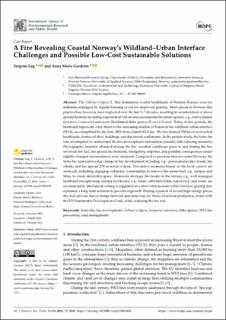| dc.description.abstract | The Calluna vulgaris L. that dominated coastal heathlands of Western Europe were for millennia managed by regular burning cycles for improved grazing. Most places in Norway this practice has, however, been neglected over the last 5–7 decades, resulting in accumulation of above ground biomass including degenerated Calluna and successional fire‐prone species, e.g., native juniper (Juniperus communis) and exotic blacklisted Sitka spruce (Picea sitchensis). Today, in dry periods, the heathland represents a fire threat to the increasing number of homes in the wildland–urban interface (WUI), as exemplified by the June 2021 Sotra Island WUI fire. The fire burned 700 ha of encroached heathlands, destroyed three buildings, and threatened settlements. In the present study, the Sotra fire was investigated to understand the fire development and analyse possible risk reducing measures. Photographic material obtained during the fire, weather conditions prior to and during the fire, involved fire fuel, fire spread mechanisms, firefighting response, and possible consequences under slightly changed circumstances were analysed. Compared to previous fires in coastal Norway, the Sotra fire represents a step change in fire development including, e.g., pyrocumuluslike clouds, fire whirls, and fire spread 270 m across a fjord. Preventive measures based on the local context are analysed, including engaging voluntary communities to remove fire‐prone fuel, e.g., juniper and Sitka, to create defensible space. Moreover, strategic fire breaks in the terrain, e.g., wellmanaged heathland strengthening existing fuel breaks, e.g., lakes, cultivated fields, naked rock, and roads, are recommended. Mechanical cutting is suggested as a short‐term measure while fenceless grazing may represent a long‐term solution to prevent regrowth. During a period of record high energy prices, this may provide free of charge firewood and make way for future local food production, in line with the UN Sustainable Development Goals, while reducing the fire risk. | en_US |

